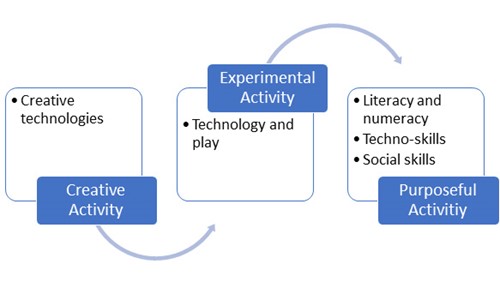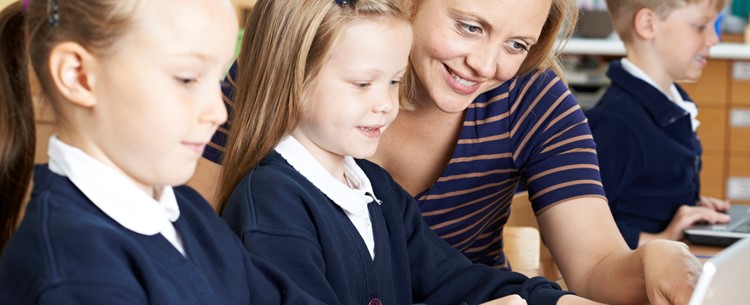By Michael Hilkemeijer
This is an extract from my play-based learning online course about “How to support play-based learning in early childhood education with Digital Technology”. You can join as a stand-alone course for $360 AUD or become a member of our ICT in Education Teacher Academy for just $43 AUD per month and gain INSTANT ACCESS to this course and 40 + online workshops for preschool teachers.
Technological pedagogical approaches in early childhood education are about having an understanding of how play-based learning changes when particular digital technologies are used. It is significant that you know the pedagogical affordances – the opportunities presented to the children by the technology – and constraints of a range of preschool technology as they relate to disciplinary and developmentally appropriate pedagogical designs and strategies.
This is important because most popular software programs are not designed for educational purposes. For example, MS Word, PowerPoint and Excel are usually designed for business use. However, they are also ideal as developmentally appropriate programs to use.
Technological pedagogical knowledge requires you to have forward-looking, creative, and open-minded in seeking digital technology in early childhood education and care.
In this video, I will show you just how you can develop your early childhood pedagogies for creative digital technology in your early childhood learning environment now.
Teacher competency
Developing a digital pedagogy in early childhood education is just not about you acquiring skills, but developing an understanding and judgement about how to use those skills appropriately. For example, you may decide when such a presentation is an effective use of the technology, but also you need to make a judgement about the class or group of children that you are teaching.
A digital pedagogy in early childhood education is about having a complex blend of skills and aptitude. This I have discussed earlier in another blog. In the early childhood learning environment, there are three elements that are central to you developing your pedagogical approaches.
Creative Activity – brings to mind hands-on learning that results in the production of an artefact, something tangible and real. For example, the creation of a painting, a finger puppet, or a robotic animal.
Experimental activity – this is concerned with creativity but also with processes, with how things work, with how something might change if you move this or change that. It could also be concerned with problem-solving.
Purposeful activity – concerned with the hard learning associated with the curriculum and the acquisition of specific content knowledge. Additionally, it is also concerned with a specific ‘chunk’ of knowledge. For example, how to turn on a computer and open a particular program.
Each of these three elements is concerned with a combination of content and process knowledge and all three can be applied to digital play-based learning.
Here is how these three elements are associated with integrating digital technology in early childhood education.


(Howell, 2012, p. 119)
What digital skills do you need?
To develop the early childhood pedagogy that will allow you to successfully integrate digital technology in preschool activities you need to develop a set of skills that are specific.
The following table will enable you to ground the development of your digital pedagogy in early childhood education on a specific set of skills.
| Type of technology | Types of skills required |
| Digital camera and images |
How to operate a digital camera (particularly the model you are using with the class). How to zoom, transfer files from the camera to PC. Familiarity with a basic image editing program – most cameras come with a program – ensure you have installed it on the computers you wish to use. Practice using the program – can you re-size, fix red eye, save, export in different sizes and formats? |
| Digital storybooks |
How to operate the program you are using to create your storybook, for example, MovieMaker, PowerPoint How to load images, add sound files, re-order images, add title and credit slides, add text narration. How to export a storybook into a format that can be used How to burn your storybook onto a DVD or CD or transfer to a USB device. |
| Interactive whiteboards |
How to use the IWB with different programs that are available in your school – how to fix basic technical problems Basic IWB skills – how to turn on/off, save work, move objects on the screen, how to use the pen or your finger to manipulate objects |
| Laptops, tablets and PCs |
All depends on the make and model of your device. Suggestions are: Laptops – how to use the mouse pad, describing to children how to use it Tablet PCs – how to calibrate the screen, how to use the touch pens, how to load programs, turn the screen around on the PC iPads – how to open apps, how to navigate settings, how to save work, how to go back. |
| LEGO robotics | How to build basic robots – practice using the step-by-step instructions, how to describe instructions to the class, how to explain the mechanisms and science, how to program the program the robot using the software, how to troubleshoot if the robot fails to move. |
| Touch tables |
How to open and close programs, how the programs work, how to save work. Familiarise yourself with how many points of touch are able to be used at one time. |
| Web-based learning |
How to conduct a simple search (for example, using Google) and explain what you are doing. How to use basic truncation. How to select an online site to use with the class. Basic computer operations – on/off, enter button, typing, mouse work. Specific skills or familiarity with the programs or website you are using |
| Bee-bots and other programmable toys |
How to program the robot, both using a computer and the buttons on the top of the robot. How to direct the robot to move in different directions. How to navigate around the floor map or chart. How to problem-solve if the robot does not move. How to change batteries |
Howell (2012, p. 120)
Let’s take a closer look at those elements discussed earlier. What skills do you need for each of those types of activities? Howell (2012) recommends the following skills:
Creative activity
Successful technology integration is about imagining the potential for learning with the technology within the context that it will be taught. So the skills needed here is only limited to your own imagination of which type of technology to use with your class. Be techno-fearless! Remember, technology integration in early childhood education is an instructional and pedagogical choice.
Experimental activity
As suggested, it is concerned with creativity, but also the processes of how things work and also problem-solving. The skills that you need to acquire include:
Good analytical abilities: Can you break down a process into a series of understandable step? Can you explain change and difference clearly? Do you understand how particular object functions, works or can be modified? Start at the beginning and assume no knowledge and work together. Remember this process – model, scaffold, then independent learning.
Problem-solving skills: Can you work out solutions to problems during lessons or do you get flustered and grind to a halt? You need a calm, problem-solving approach when solving problems with technology in order to keep the lesson going.
Inquiry-based learning: When young children are engaged in inquiry, they are engaged in complex learning tasks. You will need to consider the specific skills of the children involved, the resources, and the amount and type of guidance or scaffolding needed to ensure that they are all engaged in learning and that it progresses.
Play-based learning: this is a key learning activity in early childhood learning environments. Examples includes exploring a particular technology and building something and using a digital camera to record it. Another example includes using LEGO robots made out of LEGO bricks or programmable toys such as bee bots. Develop skills in designing learning opportunities that are play based but are strongly aligned to achieve curricular goals.
Purposeful activity
The skills that you need to acquire are associated with curriculum and specific content knowledge. It involves combining your understanding of the curriculum and syllabus documents with your skills in digital technology in early childhood education. When you design and plan your units of work, you need to consider:
- Which types of technology could be used to achieve these learning outcomes?
- Which technologies would support the learning of the students?
- Which technologies could be used to meet the needs of a variety of learning styles?
- How could technology be used to introduce, engage and motivate the class to the new topic?
- If technology is being used, what technological learnings will the class engage in?
- If technology is being used, what learning outcomes particularly associated with that technology can be listed?
- How could technology be incorporated meaningfully?
(Howell, 2012, p. 124)
The value of play based learning in early childhood education can not be underestimated. Develop your competency and confidence in digital pedagogy in early childhood learning environments with these digital skills behind you now.
40 + Online Workshops for Preschool teachers - Join our ICT in Education Teacher Academy to learn more about digital pedagogical approaches in early childhood education and care.
ALL FOR JUST JUST $43 AUD PER MONTH! CANCEL ANYTIME!
